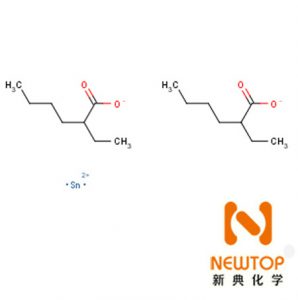Polyurethane catalyst PC-5
Overview:
Chinese name: stannous octoate, organotin T-9
Alias: Stannous octoate, Stannous octoate, Stannous octoate D19, Stannous octoate T-9, Gel catalyst T-9, Organotin T-9
Stannous octoate is a basic catalyst for the production of polyurethane foam, room temperature curing silicone rubber, polyurethane rubber, and polyurethane coatings. The chemical properties are extremely unstable and easily oxidized.
| Chinese name | stannous octoate | ||||||
| English name | Stannous octoate | ||||||
| Chemical formula | C16H30O4Sn | ||||||
| Molecular weight | 405.1 | ||||||
| CAS login number | 301-10-0 | ||||||
| Secret Degree | 1.251 | ||||||
| Main content of stannous | 28+/-0.50% | ||||||
| Corrosive: | No corrosion | ||||||
| stannous octoate | Stannous octoate | CAS 301-10-0 | stannous octoate T-9 | Gel catalyst T-9 | Organic tin T-9 | ||
Basic information:
Chinese name: stannous octoate
Alias: stannous octoate, organic tin T-9

-Based diethylene triamine polyurethane catalyst PC-5 PC5 catalyst CAS 3030-47-5 PMDETA
English name: Stannous octoate
Molecular formula (Formula): C16H30O4Sn
Molecular Weight: 405.10
CAS: 301-10-0
Density 1.251
The main content of stannous: 28+/-0.50%
Main ingredients: Content: (calculated as stannous) about 22%, total tin about 23% EC.
Appearance and traits: white or yellow paste.
Relative density (water=1): 1.251
Flash point (℃):>110
Freezing point: -20℃
Viscosity (25℃): ≤380MPa·s
Refractive index: 1.492
Solubility: insoluble in water, soluble in petroleum ether and polyol
Corrosiveness: no corrosion
Toxicity: Toxic, with strong neurotoxicity, the allowable concentration in the air is 0.1mg/m3.
Other physical and chemical properties: 1.4933
Quality Index:
Appearance [1] Light yellow transparent liquid or yellowish brown paste
chromaticity (platinum-cobalt color number) ≤6
The mass fraction of total tin ≥28.0%
stannous content ≥27.25%
Purpose:
For organic synthesis.
Stannous octoate is a white or light yellow-brown paste, sometimes called stannous octoate. Soluble in petroleum ether, insoluble in water. It is the basic catalyst for the production of polyurethane foam. It is mainly used for the gelation reaction of polyether-polyurethane foaming. It can also be used as an antioxidant for urethane foam. Used as a catalyst for polyurethane synthesis and room temperature vulcanization of silicone rubber. It is also used as a catalyst type curing agent for epoxy resin. The catalytic activity of stannous octoate is greater than that of dibutyltin dilaurate during curing. If the two are used in combination, the effect will be better than when used alone, and it can take into account the reaction speed and curing speed. Since divalent tin compounds are easily oxidized and decomposed by oxygen and water vapor in the air, they must be used for nitrogen protection during storage and must be sealed to avoid high temperature and excessive humidity to prevent activity degradation or failure.
Storage and transportation:
Should be sealed and stored in a dry, cool and ventilated warehouse
Packaging:
200KG/bucket Storage: It is recommended to store in a dry and cool area with proper ventilation. After the original packaging, please fasten the packaging cover as soon as possible to prevent the product performance from being mixed with other substances such as waterproof grade. Store in a cool, dry place, keep the container tightly closed, and avoid contact with oxides. Do not inhale dust and avoid contact with skin and mucous membranes. Smoking, eating and drinking are prohibited in the workplace. After work, take a shower and change clothes. Store contaminated clothes separately and use them after washing. Maintain good hygiene habits.


